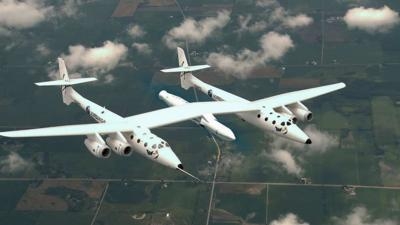Fri, Jan 16, 2015
WhiteKnightTwo Reconfigured To Carry LauncherOne
While every other gadget in our lives has gotten smaller, lighter, and cheaper, satellite technology has somehow gotten bigger, heavier, and more expensive since the days of Sputnik and Explorer I. But now, thanks to the recent advances in Cubesats and microsatellites, commercial satellite start-ups, universities, schools, and even IndieGoGo campaigns can put their own satellites into space. But small satellites need small satellite launch vehicles—after all, small satellites cannot truly change the world without cost-effective, frequent rides to space!

Current small and microsatellites reached space mostly by “hitchhiking” — catching a ride on someone else’s big, expensive rocket. But hitchhiking to space has real drawbacks: just like hitchhiking here on Earth, when you leave and where you get dropped off aren’t your decisions to make, and the driver probably has strict rules about what you can and can’t do in the vehicle. If you are just trying to prove that your satellite works in space, those restrictions may be fine, but if you are trying to build a business or accomplish a mission, you need your own ride, at the right price.
The makers, builders, and satellite entrepreneurs have done their part. It’s time for the rockets to do theirs. Sir Richard Branson says it’s time for LauncherOne.
Virgin Galactic, says they are leveraging its work building their human spaceflight program and its team’s extensive background in low-cost launch systems to create LauncherOne, an orbital launch vehicle dedicated to the small satellite market. By using much of the same infrastructure originally that supports SpaceShipTwo — in particular WhiteKnightTwo, our unique, high-performance mothership — the company says it can keep prices low while accommodating customer needs for launch availability and flexibility.
Branson said on the Virgin Galactic website that they are "hard at work finalizing the design for LauncherOne and testing its key components. LauncherOne will be a two-stage rocket, built using advanced composite structures, and powered by our new family of LOX/RP-1 liquid rocket engines. Each LauncherOne mission will be capable of delivering as much as 225 kilograms (500 pounds) to a low inclination Low Earth Orbit or 120 kilograms (265 pounds) to a high-altitude Sun-Synchronous Orbit, for a price of less than $10M. The customers we’ve already announced plan to use LauncherOne to take pictures of the Earth for humanitarian causes, to collect more accurate weather measurements, to hunt for asteroids that could represent threats and opportunities to our home planet, and to launch many other types of satellites. We’re convinced that the types of missions are only the tip of the proverbial iceberg."
More News
From 2017 (YouTube Edition): ADS-B For Airplanes And Drones… ADS-B technology developed by uAvionix has come full circle. The company began with a device developed for manne>[...]
Dead Reckoning Dead reckoning, as applied to flying, is the navigation of an airplane solely by means of computations based on airspeed, course, heading, wind direction, and speed,>[...]
"The next great technological revolution in aviation is here. The United States will lead the way, and doing so will cement America’s status as a global leader in transportat>[...]
Aero Linx: The Mooney Mite Site Dedicated to the Mooney M-18 Mite, "The Most Personal Airplane," and to supporting Mite owners everywhere. The Mooney M-18 Mite is a single-place, l>[...]
Also: Space Command Moves, Alpine Eagle, Duffy Names Amit Kshatriya, Sikorsky-CAL FIRE Collab Textron eAviation is putting the development of its Nexus electric vertical takeoff an>[...]
 Classic Aero-TV: UAvionix - Transitioning Between Manned & Unmanned Technologies
Classic Aero-TV: UAvionix - Transitioning Between Manned & Unmanned Technologies ANN's Daily Aero-Term (09.14.25): Dead Reckoning
ANN's Daily Aero-Term (09.14.25): Dead Reckoning Aero-News: Quote of the Day (09.14.25)
Aero-News: Quote of the Day (09.14.25) ANN's Daily Aero-Linx (09.14.25)
ANN's Daily Aero-Linx (09.14.25) Airborne-NextGen 09.09.25: Textron Nixes ePlane, Joby L/D Flt, Swift Approval
Airborne-NextGen 09.09.25: Textron Nixes ePlane, Joby L/D Flt, Swift Approval



